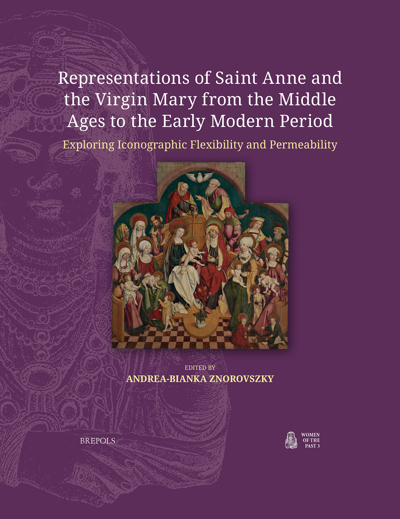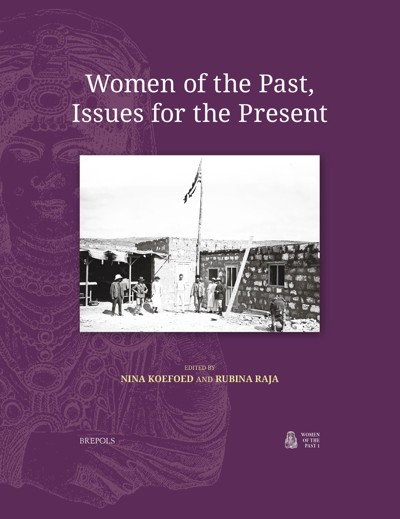
Representations of Saint Anne and the Virgin Mary from the Middle Ages to the Early Modern Period
Exploring Iconographic Flexibility and Permeability
Andrea-Bianka Znorovszky (ed)
- Pages: 189 p.
- Size:216 x 280 mm
- Illustrations:31 b/w, 39 col., 1 maps b/w
- Language(s):English
- Publication Year:2025
- € 115,00 EXCL. VAT RETAIL PRICE
- ISBN: 978-2-503-60885-3
- Paperback
- Available
- € 115,00 EXCL. VAT RETAIL PRICE
- ISBN: 978-2-503-60886-0
- E-book
- Available
The volume’s contribution to the field rests in the iconographic flexibility and permeability between the visual representations of the Virgin Mary and Saint Anne.
Dr. Andrea-Bianka Znorovszky is a Marie Skłodowska-Curie COFUND Research Fellow (2022-2025) at the University of Salamanca, Spain. She has previously received a Marie Skłodowska-Curie Research Fellowship with Ca' Foscari University, Venice (2018-2021), with a research project on Marian apocryphal representations in French hagiographic collections, and a Joint Excellence in Science and Humanities Research Fellowship from the Austrian Academy of Sciences, Vienna, Austria, in collaboration with Salzburg University (2018). She has earned her PhD in 2016, at the Central European University, Budapest, Hungary, with a dissertation on "Between Mary and Christ: Depicting Cross-Dressed Saints in the Middle Ages (c.1200-1600)".
Between the thirteenth and the sixteenth centuries, the cult of the Virgin Mary underwent significant changes, a shift clearly revealed by an increase in artistic representations of Mary, as well as a flourishing devotional literature in her honour, written in both Latin and the vernacular. One aspect of this change was a broader attention to Mary’s genealogical line, and in particular to her relationship with St Anne. The result was not only a renewed focus on the vita Annae, but also a significant overlap in how these two women were represented, juxtaposed, and perceived.
This volume traces the often significant iconographic flexibility in terms of both how the Virgin Mary and Saint Anne were presented and perceived, and what can be termed a permeability between visual representations of the two saints. Focusing on the multiple readings, layers of meaning, and the visual interplay between the vita Mariae and the vita Annae, the chapters gathered here explore the overlap and influence between different iconographic motifs, and how these were used to advance political, religious, and social ideologies at the time of their creation, as well as exploring representations across a range of different media, from sculptures and frescoes to panel paintings, and manuscript illuminations.
List of Illustrations
List of Contributors
List of Abbreviations
Representations of the Virgin Mary and Saint Anne from the Middle Ages to the Early Modern Period: Iconographic Flexibility and Permeability
Andrea-Bianka Znorovszky
1. The Panel of the Virgin and Saint Anne from the Church of the Archangels in Iprari: Iconographic and Ideological Aspects
Nina Chichinadze
2. The Anna Selbdritt and the Cult of the Three Maries: An Early Fourteenth-Century Wall Painting in the Medieval Kingdom of Hungary
Mihnea Alexandru Mihail
3. The Pregnancies of Mary-Anne in Fifteenth- to Sixteenth-Century Franco-Flemish Manuscript Illuminations: Between Iconographic Appropriation and Iconographic Development
Andrea-Bianka Znorovszky
4.‘Worthy Vestment for the Sovereign Priest’: Matriarchal Priesthood, Marian Allegory, and the Amiens Confraternity of Notre-Dame de Puy
Elliott D. Wise
5. In Mente Dei, in Gremio Annae: The Source and the Receptacle of Marian Immaculacy in Sixteenth-Century Piacenza
Fiammetta Campagnoli
6. Moving with Saint Anne: Representations of Anna Selbdritt between Central Europe and the Tyrolean Region
Stefanie Paulmichl
7. Images of Saint Anne in the Ionian Islands (Fifteenth – Eighteenth Centuries)
Eirini Panou
8. Arbor Anna Fructuosa. Apropos of an Image of Saint Anne and the Fruits of Redemption
Letícia Martins de Andrade
Conclusions
Andrea-Bianka Znorovszky
Appendix 1: Saint Anne — Primary Sources
Appendix 2: Family Tree
Appendix 3: Map
Appendix 4: Short Timeline of Mariological Doctrines and Debates




